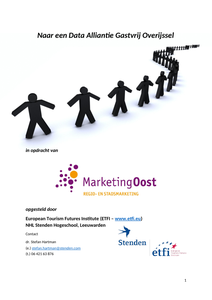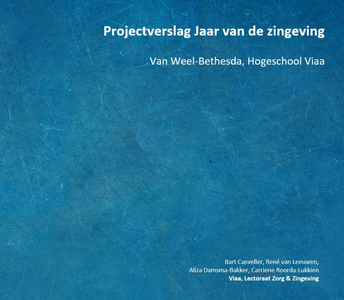Dit project poogt een bijdrage te leveren aan het versterken van “de kennisketen van de gastvrijheidseconomie” middels de volgende projectdoelstellingen: • SWOT-analyse van huidige situatie, vanuit verschillende stakeholderperspectieven: kijkend vanuit de ontwikkelopgaves die men ziet, aan welke data over de customer journey is behoefte (inventarisatie)? Wat zijn de bijbehorende sterktes, zwaktes, kansen en bedreigingen (analyse)? • Versterken van de kennisketen via: hoe kunnen we kennisketen versterken met nieuwe technieken en door slim organiseren? • Een overzicht van strategische opties: welke strategische opties zijn er om 1.) sterktes te benutten om kansen te pakken en bedreigingen af te wenden en 2.) zwaktes op te lossen door kansen te pakken en gevaren te voorkomen die met bedreigingen meekomen • Input leveren voor 2.0 versie van het manifest van Gastvrij Overijssel en de beoogde oprichting van een “Data Hub” (waarvoor nog geen officiële werktitel) In de opvolgende hoofdstukken en paragrafen gaan we in op de aanpak (hoofdstuk 2) en de uitkomsten (hoofdstuk 3).
DOCUMENT

In opdracht van de Dienst Stedelijke Ontwikkeling en Beheer gemaakte sociale analyse van de wijk Lakerlopen in Eindhoven in het kader van de integrale wijkvernieuwing. Lakerlopen is statistisch gezien een van de 'slechtse'wijken van Eindhoven. Dit onderzoek heeft als insteek de sociale relaties tussen bewoners onderzocht. In de wijk worden bijna 30 leefgebieden onderscheiden. Leefgebieden zijn die pleintjes, straten, flats e.d. wat bewoners tot hun directe woonomgeving rekenen, en waarbij zij zich erg betrokken voelen. Dit onderzoek toont aan dat het niveau van de sociale relaties in de leefgebieden voornamelijk op of boven de gestelde norm zit. Voor vele betrokkenen, van actieve bewoner tot stedebouwkundige, was dit een verrassende uitkomst; het zorgde voor nieuw elan in de wijkvernieuwing, en een andere kijk op aandachtswijken in Eindhoven.
DOCUMENT

The aim of this project & work package is to develop a European action plan on mental health at work. A major and essential ingredient for this is the involvement of the relevant stakeholders and sharing experiences among them on the national and member state level. The Dutch Ministries of Health and Social Affairs and Employment have decided to participate in this “joint action on the promotion of mental health and well-being” with a specific focus on the work package directed at establishing a framework for action to promote taking action on mental health and well-being at workplaces at national level as well.
DOCUMENT

SMEs represent a very important part of the European economy today, and within this SME group the creative sector is recently one of the fastest growing sectors. Our paper studies the innovation management of 105 creative SMEs in Flanders and the Netherlands, based on the innovation diagnostic instrument, developed by Mazzarol & Reboud (2006). On the side of the „innovation climate‟ we identified many stimulating factors such as the well developed infrastructure and proximity of logistics and suppliers and an innovative and stimulating life style in the global area of Flanders and the Netherlands. However, we identified many restricting legislations and regulations that seem to hamper seriously most creative SMEs. Above that, many creative SMEs fail to find sufficient access to capital to invest in their growing innovative activities. We observe that the Dutch creative SMEs find more easily access to external financial resources and governmental support and subventions than their Flemish colleagues. Finally, the use of managerial tools like a SWOT analysis or setting up a solid financial or business plan seems very uncommon but required among creative SMEs.
DOCUMENT

Context When the pandemic hit the world, teachers were forced to change their education from onsite to virtual overnight Understandably, teaching quality decreased in the beginning, as there was little experience in how to adapt the educational design Zuyd University of Applied Sciences ( recognized the problem that teachers were on different didactic and pedagogical levels when it comes to online education Unfortunately, the pandemic made it hard for teachers to connect with each other In the Domain of Health and Welfare, this led to the idea of establishing a professional learning community A professional learning community ( can be seen as an informal group of people who share knowledge and experiences among each other on a common topic they are all highly interested in Zuyd’s vision “passion for development” sets a good basis for the start of such a community. Steps we took In order to find out how a professional learning community can look like in Zuyd, the following steps were taken Firstly, we collected and evaluated literature and best practices around the topic Based on our findings we developed an interview guideline and conducted interviews with eight teachers from the Domain of Health and Welfare Throughout the whole report a SWOT analysis was performed with the literature and best practices filling opportunities and threats and the interviews providing content for strengths and weaknesses Main findings From these sources, we derived enablers for a successful learning community, which led to recommendations for Zuyd on how to strategically position, implement and organize a PLC One of our major recommendations is to make didactic and pedagogical skills an important topic within Zuyd in order to strategically implement the learning community into Zuyd’s strategy Furthermore, we recommend giving the lead in organizing and facilitating the PLC to the blended learning task force To collect a diverse set of interested employees to the core group, the educational managers should personally approach teachers that might be interested The sense of urgency around the topic needs to be addressed regularly through the directors of the Domain, the task force of blended learning, as well as the PLC itself In this way, interest in the topic of didactic and pedagogical skills and blended learning can be enhanced In the report we go into greater detail on how to organize and apply these recommendations. We are convinced that implementing these steps will pay off in the future and will successfully enhance competencies on blended learning and didactic and pedagogical skills through knowledge exchange.
DOCUMENT

In dit boek wordt het planningsproces voor marketingstrategieën op een toegankelijke wijze uitgelegd. Ieder hoofdstuk betreft een stap in het strategische marketingplanningsproces. Iedere stap wordt geïllustreerd met praktische voorbeelden en een slotcase, daarnaast worden per stap handige tools gepresenteerd.In deze achtste editie wordt digitale marketing volledig geïntegreerd in alle planningsstappen. Niet alleen online communicatie wordt behandeld, maar digitale marketing in de volle breedte, als onderdeel van de 'gewone marketing'. Ook is een nieuw 'Canvas model' ontwikkeld. Verder zijn de afnemers- en SWOT-analyse vereenvoudigd. Daarnaast zijn alle voorbeelden en praktijkcases vernieuwd, zodat ze nog beter aansluiten op de nieuwste ontwikkelingen en trends op het gebied van marketing.
LINK
Onderzoek in opdracht projectgroep Leef en Leer! (bestaand uit ObA, gemeente Amsterdam, E-TV en AT5) om onderzoek te doen naar de kwaliteit van netwerkvorming en netwerkintelligentie en de manier waarop die netwerkvorming ondersteund kan worden met een goed hanteerbare communicatiestructuur. Leef en Leer! wil in de wijken digitale geletterdheid van Amsterdammers in aandachtsgroepen versterken. Onderzoek is gebaseerd op kwalitatieve interviews met stakeholders en adviseert over verdere netwerkvorming in de eerste uitrolfase van de Leef en leer! pas aan eindgebruikers. Analyse is gebaseerd op de verschillende manieren waarop betrokkenen meenden dat zijzelf of anderen iets 'moesten'. Het 'moeten' werpt ligt op de normatieve en idealistische kant aan het Leef en Leer! netwerk en op haar meer disciplinaire kant. Dit valt terug te voeren op het langzaam duidelijker worden van de aard van het Leef en leer! netwerk. Het idealisme van de stuurgroep en later aangesloten wijkpartners verhoudt zich goed tot een transformatief netwerk en slecht tot een netwerk dat gericht is op institutionalisering.
DOCUMENT
Een verbetering van de effectiviteit heeft de grootste invloed op een verhoging van de productiviteit. Effectiviteit is veel belangrijker en bepaalt mede de efficiency. Eerst denken dan doen, eerst wat dan hoe.
DOCUMENT

In samenwerking met het lectoraat Zorg en Zingeving van Hogeschool Viaa te Zwolle heeft een stuurgroep activiteiten voorbereid om met het verpleegkundig personeel aandacht te geven aan zingeving. Gedurende het jaar 2018 bevorderen zij via bijeenkomsten en een e-learningmodule bewustwording en deskundigheid. Bovendien zal een aantal verpleegkundigen fungeren als Aandachtsvelder Zingeving, zodat ook de borging in teamfunctioneren, methodisch handelen en multidisciplinaire samenwerking vorm krijgt. Tot slot zal met behulp van onderzoek en kennisdeling aandacht voor zingeving versterkt worden.
DOCUMENT

This chapter presents the currently not established and identifies design requirements for new systems to address this challenge and provide directions for possible improvement. As a result, this chapter introduces the concept of SamenMarkt®, a participatory system in which multi-agent system technology enables distributed price negotiation, distribution and communication between producers, retailers and consumers.
LINK